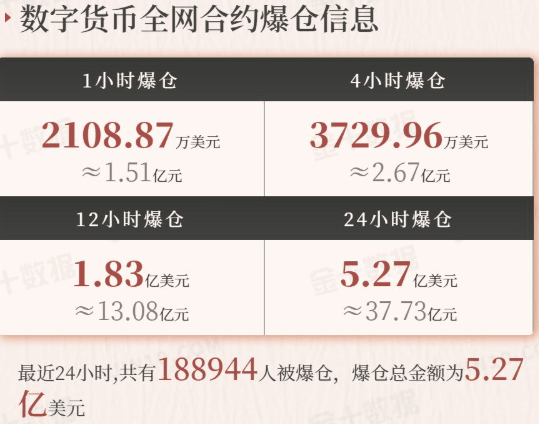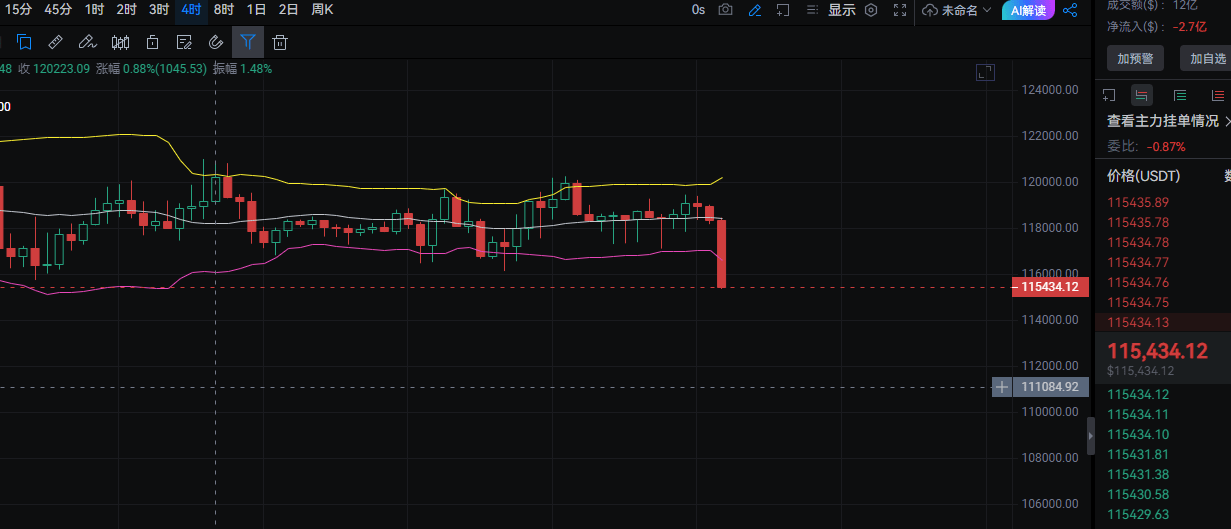"The crypto market does not have eternal euphoria, only periodic storms — the Bitcoin crash on July 25 was a 'perfect storm' hit by fourfold thunderstorms at the same time!"
1. This drop is essentially the market 'collectively hitting the brakes'
Bitcoin's four-hour plunge from $119,000 to $115,500 appears to be price volatility on the surface, but in reality, the market is voting with its feet: when technical resistance, policy variables, leveraged euphoria, and option traps explode simultaneously, even the strongest upward momentum can be instantly drained.
For example: It's like a Tesla speeding down the highway, suddenly encountering road construction ahead (technical resistance), navigation prompting a speed limit (policy uncertainty), passengers in the back seat shaking the car wildly (leveraged liquidation), and finally, the driver finds out the brake pads have been chewed by mice (option expiration causing market maker to depress prices) — it’s a miracle if it doesn't crash!

2. My core viewpoint: This drop is a 'healthy adjustment', but short-term risks remain unresolved
1. Technical aspect: Resistance levels are not 'paper tigers', but 'real tigers'
Bitcoin has repeatedly surged and retreated in the $119,000-$120,000 range; essentially, the market is testing the 'psychological ceiling'. Just like during the 2021 bull market, the $64,000 resistance took three months to break, this needs time to digest as well. If the greed index is at 71 (high-risk zone) and you're still not running? Then you're considering yourself the 'chosen one'.
2. On the policy front: Trump's 'Treasury Secretary card' disrupted the rhythm of the crypto market
After Basent was nominated as Treasury Secretary, U.S. long-term Treasury yields plummeted, with funds flooding into 'safe assets' — but this time the safe asset is U.S. Treasuries, not Bitcoin. It's like discovering a gold mine in your backyard; who would still go to the neighboring village to buy virtual jewelry? More critically, the new Treasury Secretary's attitude towards cryptocurrencies is unknown, so the market naturally chooses to 'withdraw first for safety'.
3. Leverage liquidation: 85% of long positions being liquidated is 'the cost of greed'
In the past 24 hours, $956 million in liquidations occurred, with 85% being long positions, the largest single liquidation being $2.96 million on Binance. The most typical case is the 'Maji Brother's' ETH+PUMP combo, which lost $8.14 million — it’s like betting your entire fortune on 'big or small' in a casino, only to find the dealer keeps hitting 'push' ten times in a row. High leverage is a 'money printer' in a bull market, but a 'meat grinder' in a choppy market.
4. Option expiration: Market makers' 'price suppression game' turns retail investors into cannon fodder
On July 26, 18,000 BTC options expire, with strike prices concentrated between $85,000 and $100,000. Market makers will intentionally push prices down to the 'maximum pain point' (the price that causes the most option buyers to lose) — it’s like a teacher suddenly highlighting exam topics, only for the highlights to be all 'unexaminable questions'. Retail investors can only passively endure the cuts.
5. Capital rotation: Bitcoin 'loses favor', altcoins 'rise to prominence'
Bitcoin's dominance has dropped below 60%, with funds flowing into Ethereum (up 1.25% in 24 hours) and other ecological tokens like Solana. It’s like in the stock market, where capital retreats from blue-chip stocks and floods into small-cap growth stocks — it's not that blue-chips are bad, but small-caps are 'more exciting'. But can this rotation continue? It depends on whether altcoins can catch this wave of traffic.

3. How to move forward? It all depends on these three 'traffic lights'
1. Short-term support level: $115,000 is the 'lifeline'
If it breaks, it may dip to $112,000 (76.4% Fibonacci retracement level); if it can hold, it may rebound to the $117,000-$118,000 range. It’s like playing a game; $115,500 is the 'respawn point', if it can't hold, you'll have to restart.
2. Policy and events: The White House report on July 30 and the Federal Reserve's rate cut in September
The White House's digital asset report may reshape regulatory expectations (such as clarifying ETF approval rules), and the Federal Reserve's interest rate cuts will affect macro liquidity — one is a 'rulebook', the other is a 'fuel package'; whichever comes first will be the market's focus.
3. Institutional behavior: Does MicroStrategy's 'trump card' still exist?
MicroStrategy's average holding cost is around $88,700; if Bitcoin stays below $117,000, short-term buying support may weaken. But don't forget, this company still holds 215,000 BTC, equivalent to a 'nuclear button' — if it really drops near the cost line, they may even increase their positions.
Is this drop a signal of the end of the bull market? Or a 'deep squat' during an upward trend? I bet on the latter — because institutional accumulation hasn't stopped, the expectation of the halving in 2025 still exists, and market sentiment is just temporarily 'under the weather'. However, short-term fluctuations will continue; friends looking to buy the dip should remember to bring a 'stop-loss shield' and a 'patience sword'.
If you don't know what an effective breakout is, you can come to find us for guidance. Are you stuck? Don't know when to enter? As always, if you're confused and helpless, just click on my avatar to comment. I need fans; you need references.



